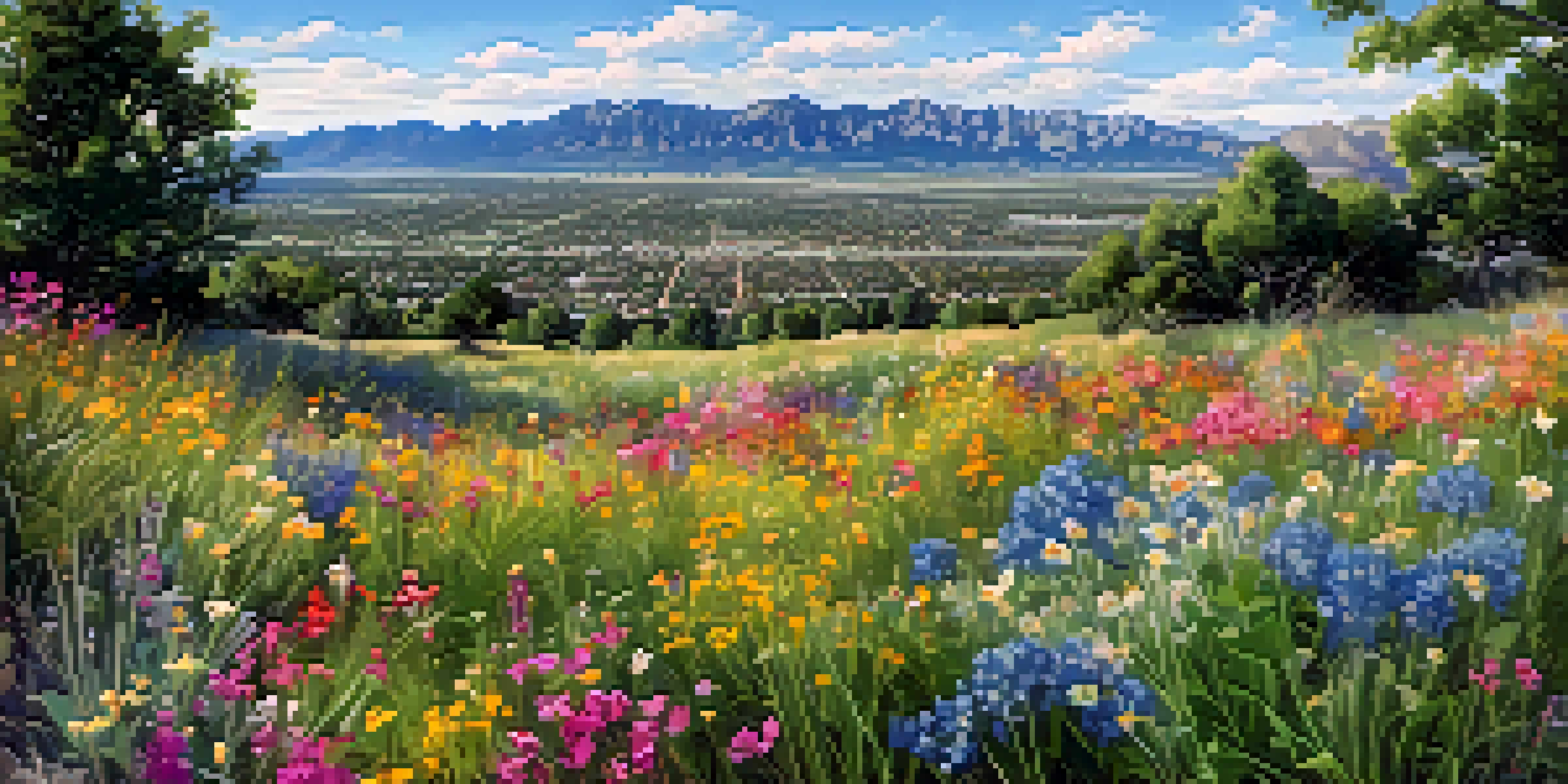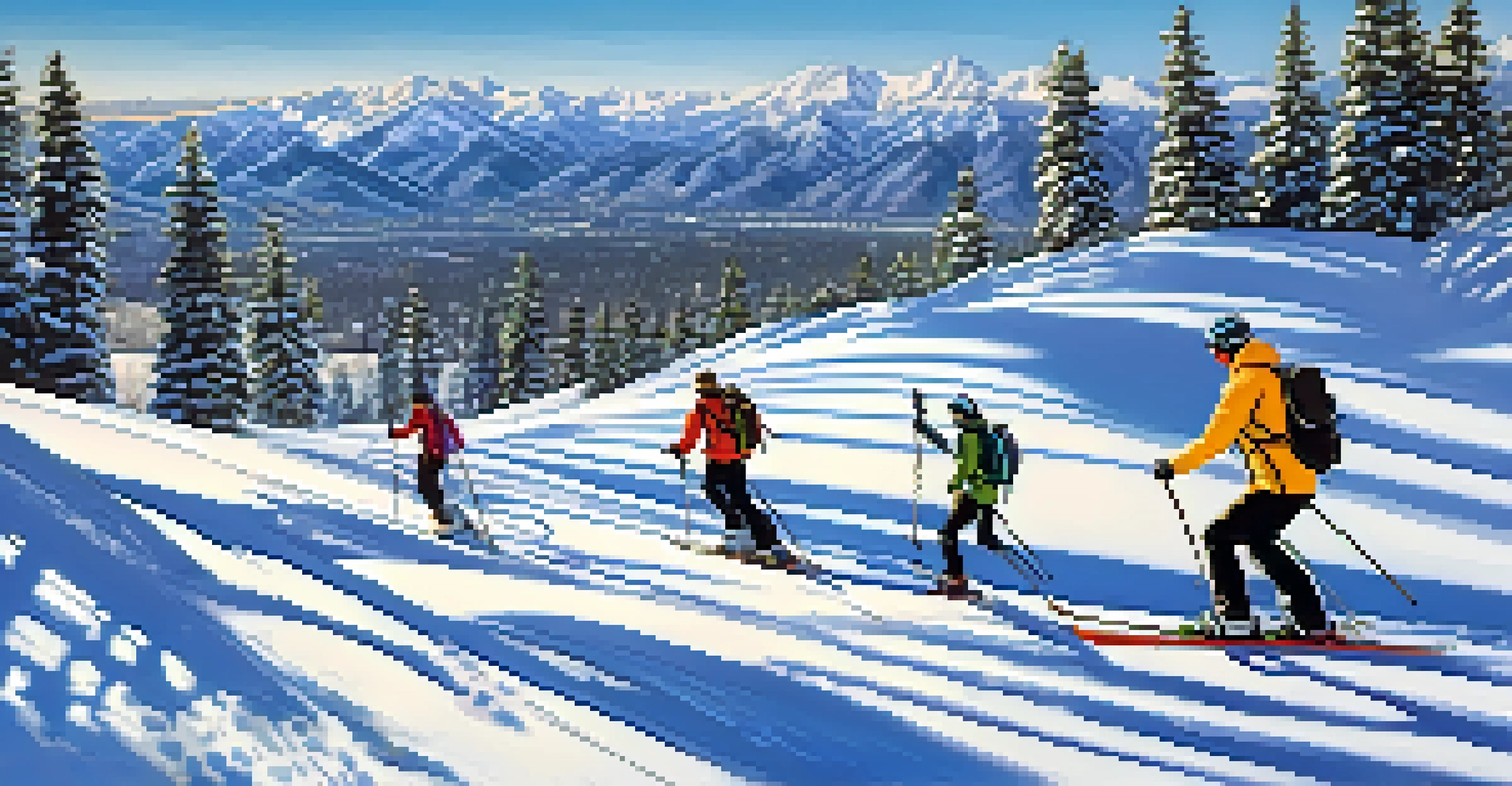The Role of Elevation in Boulder's Unique Climate Traits

Understanding Boulder’s Elevation and Geography
Boulder, Colorado, is nestled at an elevation of about 5,430 feet, making it a unique spot for climate study. This high elevation significantly influences not just the temperature, but also other weather patterns in the area. The city is surrounded by the stunning Rocky Mountains, which further affect local climate conditions, creating a microclimate that’s distinctly Boulder.
The mountains are calling and I must go.
Because of its elevation, Boulder experiences thinner air, which means less atmospheric pressure. This can lead to more intense sunlight and quicker temperature fluctuations between day and night. Residents and visitors alike often feel the sun's intensity, contributing to Boulder's reputation for having more sunny days than many other regions.
Moreover, the altitude affects precipitation levels, resulting in a semi-arid climate. With average annual precipitation around 20 inches, Boulder is drier than many other Colorado cities, which influences everything from local flora to outdoor activities.
Temperature Variations and Daily Cycles
One of the most notable climate traits of Boulder is its temperature variation. The higher elevation contributes to significant temperature drops at night, which can be quite surprising for newcomers. While daytime temperatures can soar in the summer, nights often cool down considerably, leading to a refreshing environment for evening activities.

This phenomenon is due in part to the thin atmosphere, which allows heat to escape more quickly after sunset. Consequently, residents often experience a wide range of temperatures throughout the day, making it essential to dress in layers. That way, they can easily adjust to the changing conditions as they enjoy outdoor adventures.
Boulder's Unique Climate Effects
Boulder's high elevation creates a distinct microclimate that influences temperature, precipitation, and air quality.
In winter, Boulder’s elevation leads to colder temperatures and occasional snowfall, but the sunny days often follow storms, providing a beautiful contrast. This combination creates a unique winter playground for skiing and snowboarding enthusiasts, who can enjoy the sunshine almost as much as the snow.
Impact of Elevation on Air Quality
Boulder's elevation also plays a role in its air quality, particularly during different seasons. Higher altitudes can lead to lower levels of air pollution, making Boulder one of the cleaner cities in the United States. The thinner atmosphere means that pollutants can disperse more easily, which is a significant advantage for those who enjoy outdoor activities.
Nature does not hurry, yet everything is accomplished.
However, this same elevation can also mean that pollen and allergens can travel further and be more concentrated at times. For allergy sufferers, this can be a double-edged sword, as they may find relief from pollution but suffer from seasonal allergens. Understanding this balance is crucial for residents who want to maintain their health while enjoying the outdoors.
Additionally, Boulder's unique climate and elevation create conditions that can lead to increased wildfire risk. During dry seasons, residents are urged to stay informed about fire safety and air quality alerts, balancing the joys of living in such a beautiful landscape with the need for caution.
How Elevation Affects Vegetation and Wildlife
The elevation of Boulder directly influences its rich biodiversity, affecting both vegetation and wildlife. The unique climate supports a variety of plant species that are adapted to thrive in high-altitude conditions. From drought-tolerant plants to those that flourish in cooler temperatures, the local flora tells a story of resilience and adaptation.
Wildlife in Boulder is similarly affected by the elevation. Species such as elk, deer, and various birds have adapted to the climate, with different habits and behaviors that align with seasonal changes. For example, many animals migrate to lower elevations during the harsh winter months, showcasing the dynamic relationship between elevation and wildlife habits.
Recreation in the Great Outdoors
The city's elevation fosters a variety of outdoor activities, from hiking and biking to skiing and snowboarding.
Furthermore, the city’s commitment to preserving natural habitats allows for a balanced ecosystem that thrives in the face of climatic challenges. Local parks and open spaces provide residents with opportunities to connect with nature, all while appreciating the unique environmental factors that contribute to Boulder's charm.
Recreational Opportunities Influenced by Elevation
Boulder's elevation provides a playground for outdoor enthusiasts, offering a range of recreational activities. Hiking, biking, and rock climbing are just a few of the adventures that draw locals and visitors alike to the area's stunning landscapes. With numerous trails and climbing routes accessible from the city, there's always something new to explore.
The elevation also allows for unique winter sports opportunities, such as skiing and snowboarding in the nearby mountains. Many residents take advantage of the proximity to winter resorts, often spending weekends on the slopes. This blend of outdoor activities has fostered a strong community centered around nature and adventure.
Moreover, the city's elevation contributes to a vibrant culture of fitness and health. With so many opportunities to enjoy the great outdoors, Boulder's residents tend to prioritize an active lifestyle, which is reflected in the city's numerous fitness events, running clubs, and outdoor festivals.
The Role of Elevation in Local Culture and Lifestyle
Boulder's elevation and unique climate have shaped not only its environment but also its culture and lifestyle. The city's residents often embrace outdoor living, with many community events centered around nature and sustainability. This lifestyle encourages a deep appreciation for the outdoors and an active engagement with the surrounding landscape.
Additionally, the elevation and climate influence local cuisine, with many restaurants incorporating fresh, locally-sourced ingredients that thrive in the unique environment. Seasonal menus often highlight the best of what Boulder has to offer, showcasing the connection between the land and the table. This creates a sense of community among residents who value supporting local farmers and businesses.
Cultural Impact of Elevation
Boulder's elevation shapes its community lifestyle, promoting outdoor engagement, sustainability, and local cuisine.
Boulder's culture also embraces innovation and sustainability, driven by the challenges posed by its elevation. Residents and local organizations often collaborate on projects aimed at preserving the environment and promoting eco-friendly practices, ensuring that the beauty of Boulder can be enjoyed for generations to come.
Adapting to Boulder's Unique Climate Traits
Living in Boulder means adapting to the unique climate traits that come with its elevation. For newcomers, this might mean learning to dress in layers or understanding how to stay hydrated in the dry climate. Adjusting to the temperature swings can take time, but locals often find joy in the challenges and rewards that come with living in such a dynamic environment.
Moreover, residents often become adept at planning their outdoor activities around the weather patterns influenced by elevation. Knowing when to expect sunny days or sudden storms can help maximize enjoyment of the great outdoors. This sense of awareness fosters a strong connection to the landscape and encourages a proactive approach to outdoor adventures.

Ultimately, the charm of Boulder lies in its ability to blend elevation with lifestyle, creating a unique experience for all who call this city home. Embracing the local climate and all its quirks is part of what makes living in Boulder a rewarding adventure, filled with opportunities for exploration and connection.